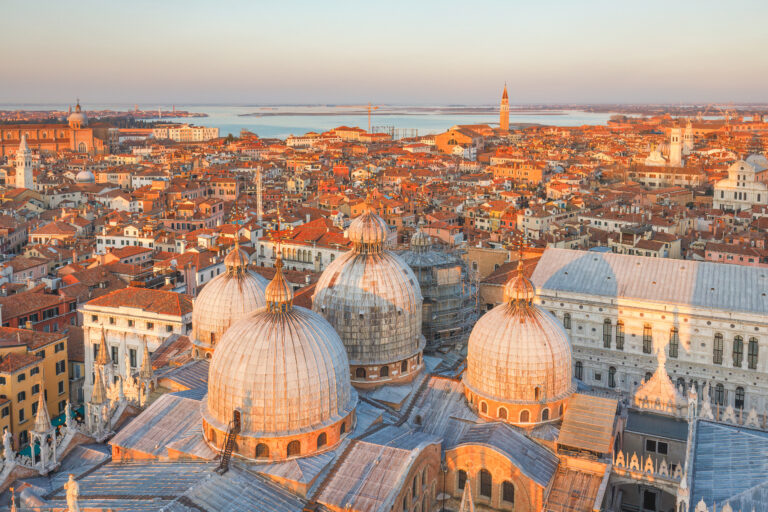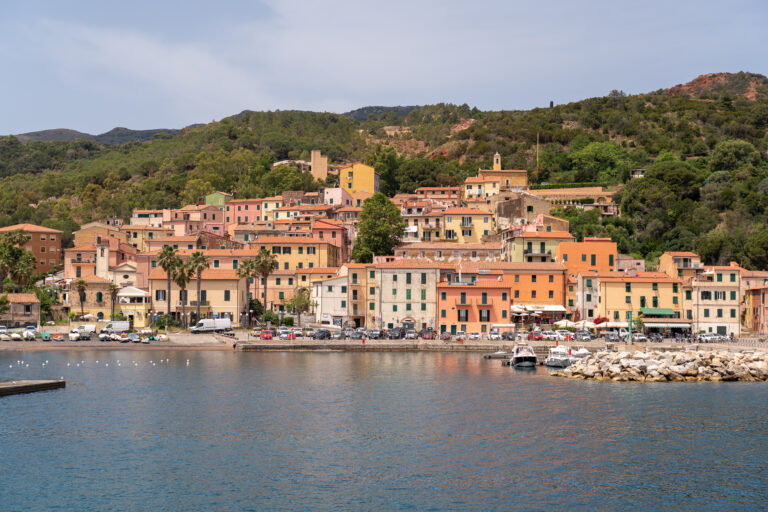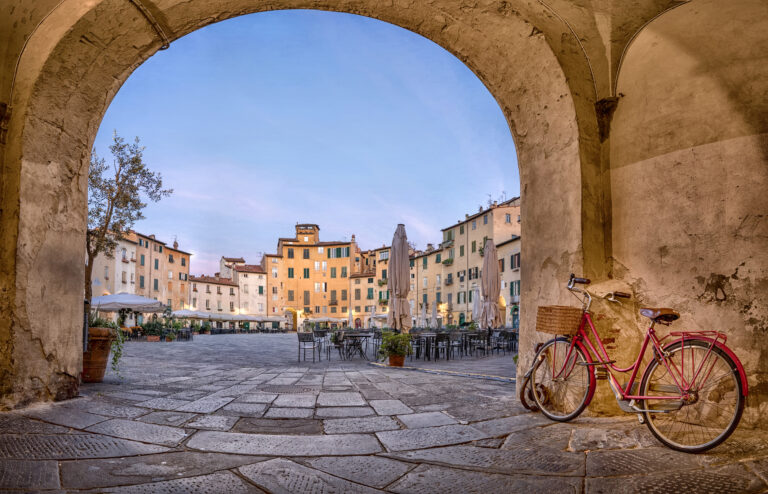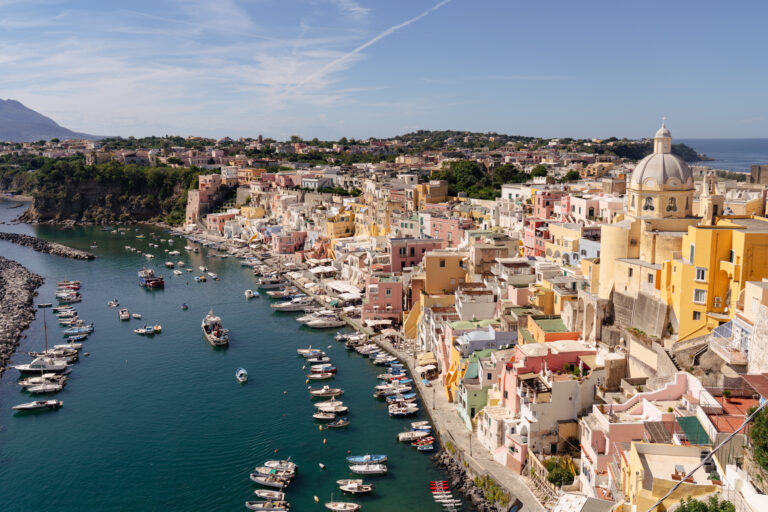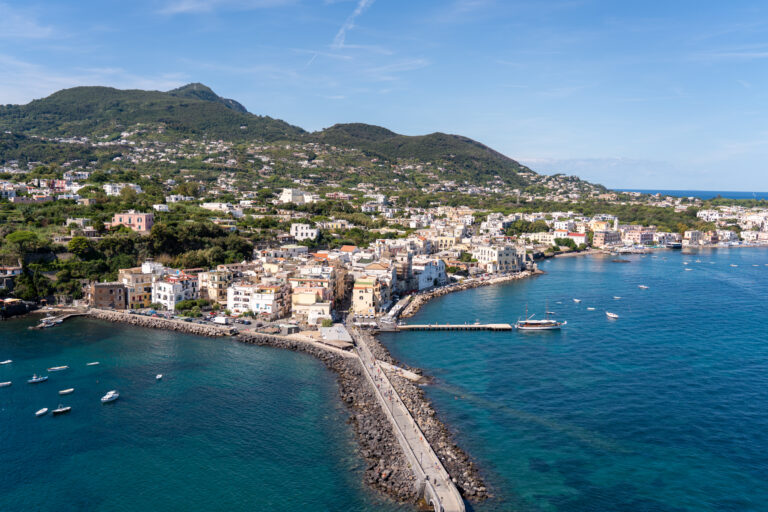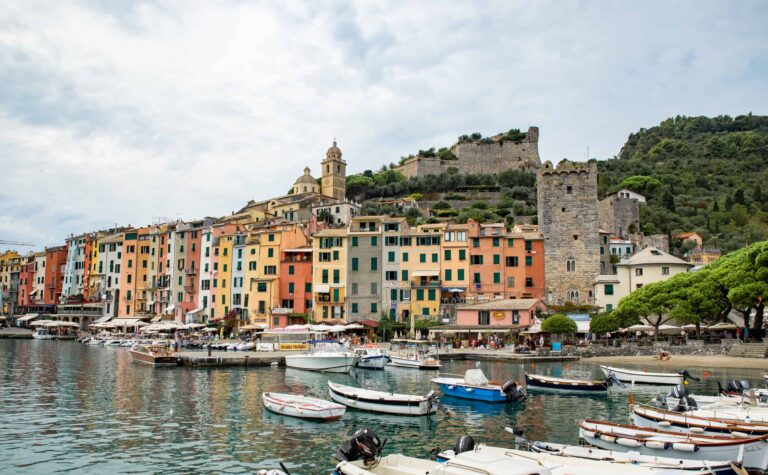Ultimate Guide to Visiting The Towns of Cinque Terre, Italy
Picture a dream Italian coastal town, and the 5 towns of Cinque Terre will likely come to mind. Perched on the cliffs overlooking the Mediterranean, the narrow, pastel-coloured houses stand tightly together surrounded by terraced vineyards, olive groves, lemon orchards, and lush greenery of the land, while the rocky cliffs plummet down to the turquoise sea.
The denomination as a National Park and a Unesco World Heritage Site, as well as its inaccessibility and rough terrain, has preserved the area from overdevelopment and left the compact settlements and the spectacular agricultural landscape almost in their original state.
The area is an appealing combination of Italian port town romance, traditional viticulture steeped into stone-walled terraces, and a nature escape, with a net of hiking trails connecting the villages and circling above them. The appeal only deepens with the availability of local wine, olive oil, and delicacies such as pesto genovese, lemoncino, focaccia, anchovies- all staples of the Ligurese cuisine.
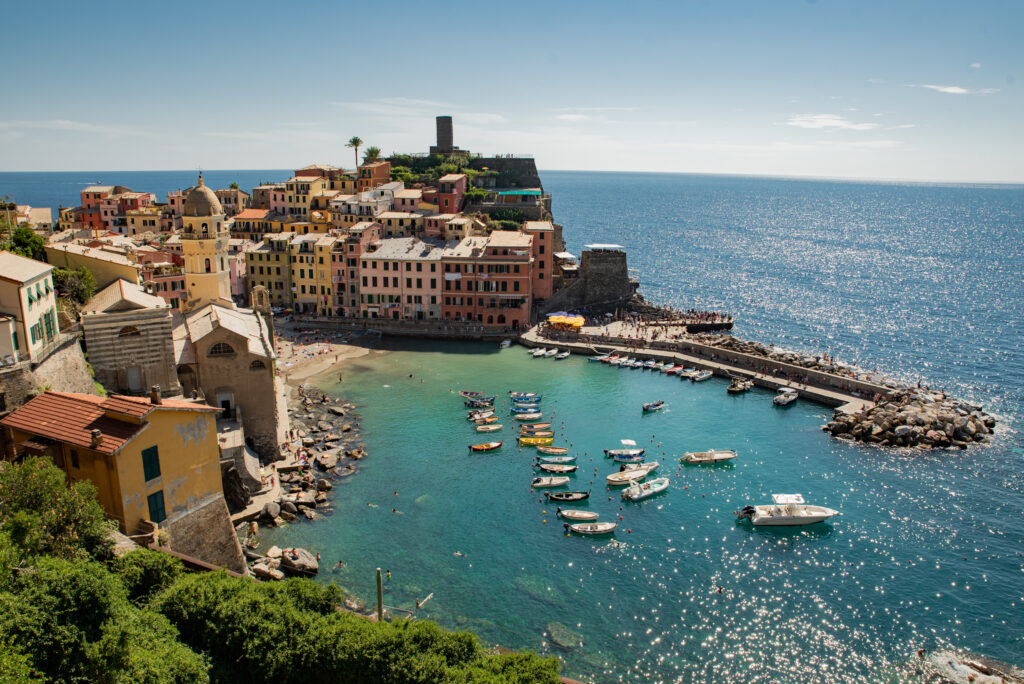
Related Reading: Most Beautiful Coastal Towns in Italy
Table of Contents
The Best Time to Visit Cinque Terre
While summer is the obvious choice for those seeking a “culture meets nature meets beach-time” type of vacation, the best time of year to visit Cinque Terre might actually be early spring and autumn.
With fewer crowds and mild temperatures, the overall experience is much more enjoyable, especially if we take into consideration that visiting in shoulder season takes the pressure off the small villages and trails that can only take a certain amount of tourists.
Add the wildflower carpet of the early spring or the appeal of the crimson vineyards in autumn to the equation, and since this is the Mediterranean after all, al fresco dining and sunshine will most likely be a part of the holiday, too.
Winter has its downside of shorter and colder days, less frequent traffic connections, and partially closed restaurants and shops, but it could also provide for a more tangible feel of what it’s like to live in those places all year round. Visiting the Cinque Terre in winter is also a wonderful way to support local businesses that are struggling to stay open year-round. Plus, you will have some spots all to yourself!
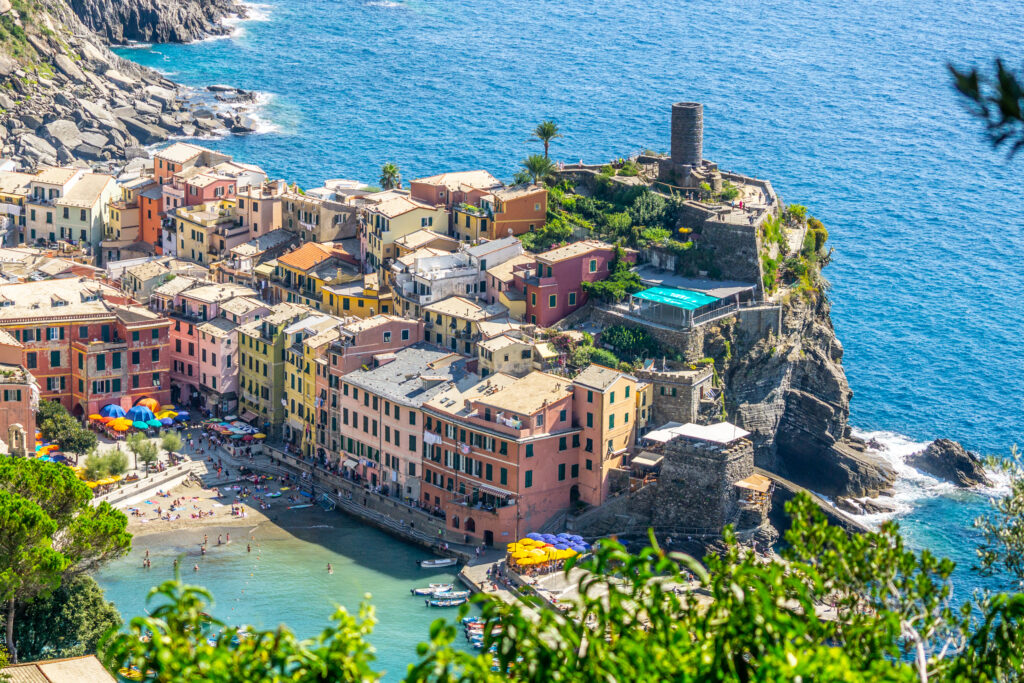
How to get to Cinque Terre
Due to its rugged landscape, the five villages of the Cinque Terre were quite inaccessible, except by the sea, until the railway connecting Genoa and La Spezia was built in the 1870s.
Today, there are several options for getting to Cinque Terre, including a train (which is probably the easiest way), a car, or a ferry boat. If you are landing at the nearest Pisa Airport, you would have to get to Pisa Centrale Train Station first, and then take the train to one of the Cinque Terre villages (for most you will have to change trains at La Spezia).
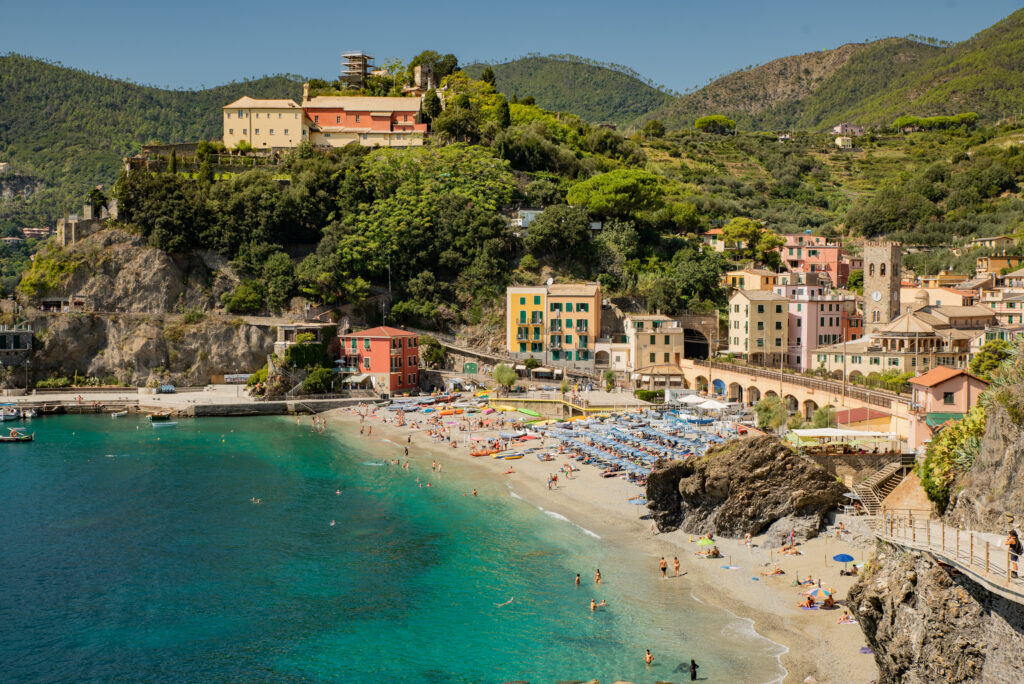
Arriving by car is possible, but even though you will be rewarded with wonderful vistas, take note that the road is narrow, steep, and winding, and the parking options are limited. You will not be able to enter the villages by car wither, but instead, leave it on the outskirts at the designated parking areas.
Alternatively, you can take a ferry from Levanto, La Spezia or Portovenere to Monterosso al Mare, Vernazza, Manarola, and Riomaggiore (excluding Corniglia which doesn’t have ferry access).
Finally, you can book a boat tour from La Spezia, such as the options shown below:
How Long to Spend in Cinque Terre
Deciding how many days to spend in Cinque Terre will depend on your travel preferences. While you could theoretically visit all 5 villages of Cinque Terre during one frenetic day using the hop-on, hop-off train, or boat option, we strongly recommend you to stay at least two to three days for a more complete experience of the region.
Three full days would allow you to visit all the villages at a relaxed pace, take at least one hike between or above the villages, spend some time tasting the local wine, olive oil, pesto Genovese, or limoncino liqueur, and thus support the traditional farming methods and viticulture that have existed in this rugged area for almost a millennium.
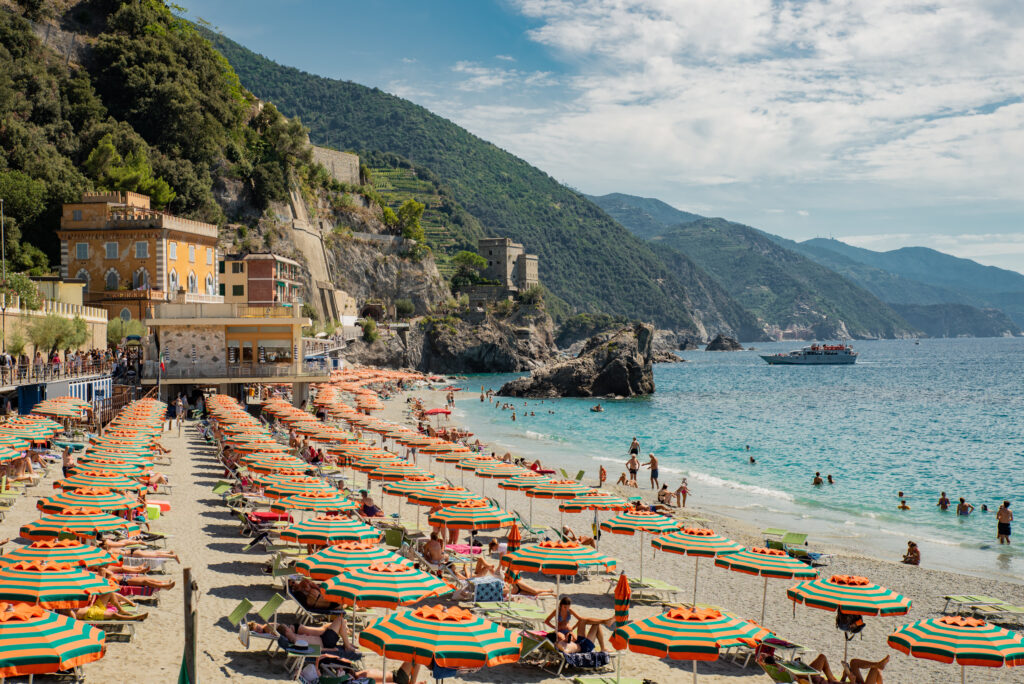
If you would like to combine culture, gastronomy, and outdoor activities with a beach holiday, a week in Cinque Terre would be enough to do a bit of each.
Taking into consideration that Cinque Terre is heavily affected by overtourism, especially in terms of day-trip bus tour groups, staying inside the park, supporting the local businesses, and taking time to get to know the region, its cuisine, and customs, is a step towards more sustainable travel.
How to get Between the Five Villages of Cinque Terre
If you’ve been wondering how to travel between Cinque Terre villages, there are several options, including a train, a boat, a car, and your feet – as the park has a wide net of hiking trails connecting the villages.
Visiting Cinque Terre by train is the most convenient option: the Cinque Terre Express Train connects all five villages, the rides between the villages last only a couple of minutes each, and the train stations are conveniently located in or near the village centres (except in Corniglia, where a steep climb, or a short trip on a shuttle bus up to the village awaits).
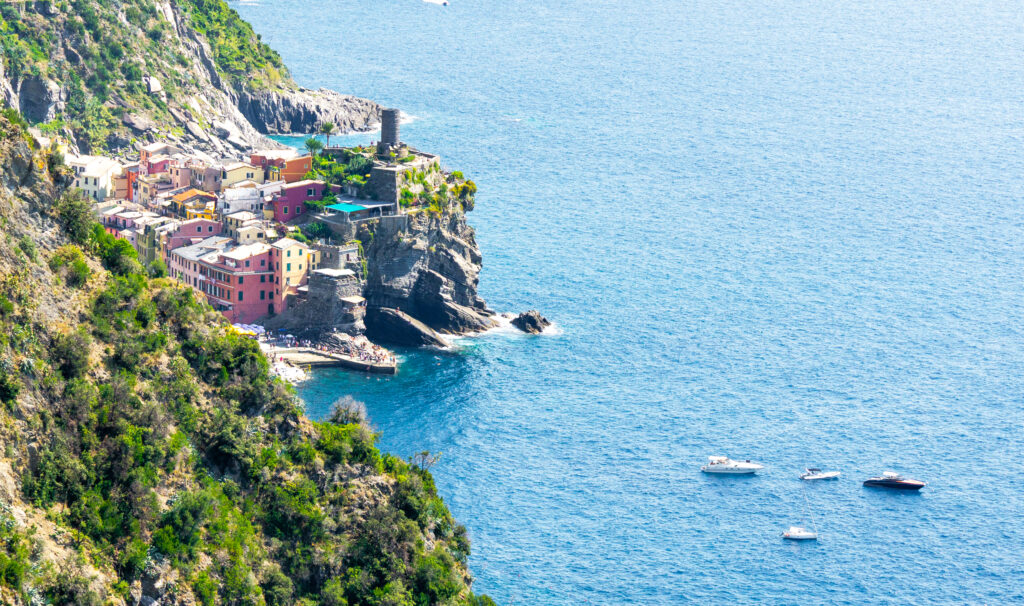
It’s recommended to buy the Cinque Terre Train Card for a little less than 20 Euros for one day, which then includes the unlimited number of rides (hop-on, hop-off system) and covers the entrance to the National Park and use of all the hiking trails as well (some trails are admission-free, but the most popular ones that connect the villages are not).
If you are staying inside the park, buying a daily Cinque Terre ferry ticket for around 30 Euros will allow you to take unlimited ferry rides by hopping on and off and visiting the villages as you like. Unfortunately, these aren’t available online and have to be purchased at the ticket booths near where the ferries depart.
Cinque Terre Villages
The five main villages of Cinque Terre, starting from Monterosso al Mare and then descending southeast to Vernazza, Corniglia, Manarola, and Riomaggiore, have been standing here since the late Middle Ages.
Unesco listed the villages and their adjacent agricultural land as a World Heritage Site – a unique combination of dramatic coastal landscape, compact settlements, and spectacular stone-walled terraces shaped over a thousand years by traditional farming methods.
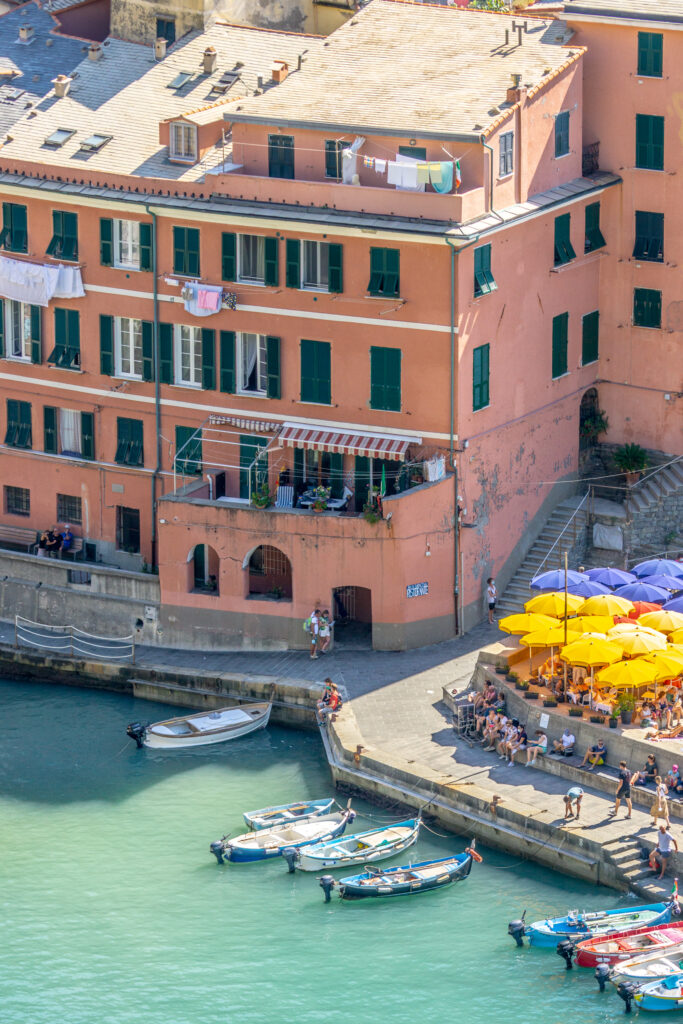
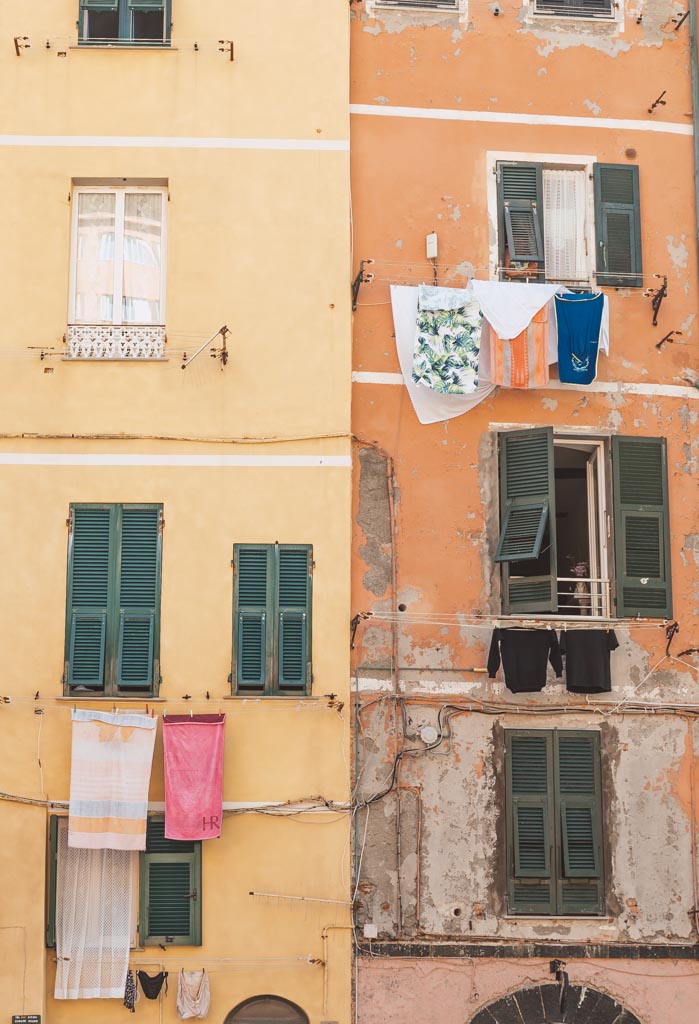
While all five of the Cinque Terre towns are as beautiful as the postcards depicting them, and somewhat similar in terms of all having clusters of pastel-hued houses, each has a distinct aura of its own. Some are quieter, some aare busier, some have an artistic vibe, while others are known for their gastronomic offerings. Some even have swoon-worthy beaches.
Keep on reading to find out more about these iconic Cinque Terre attractions and how to appreciate them fully!
MONTEROSSO AL MARE
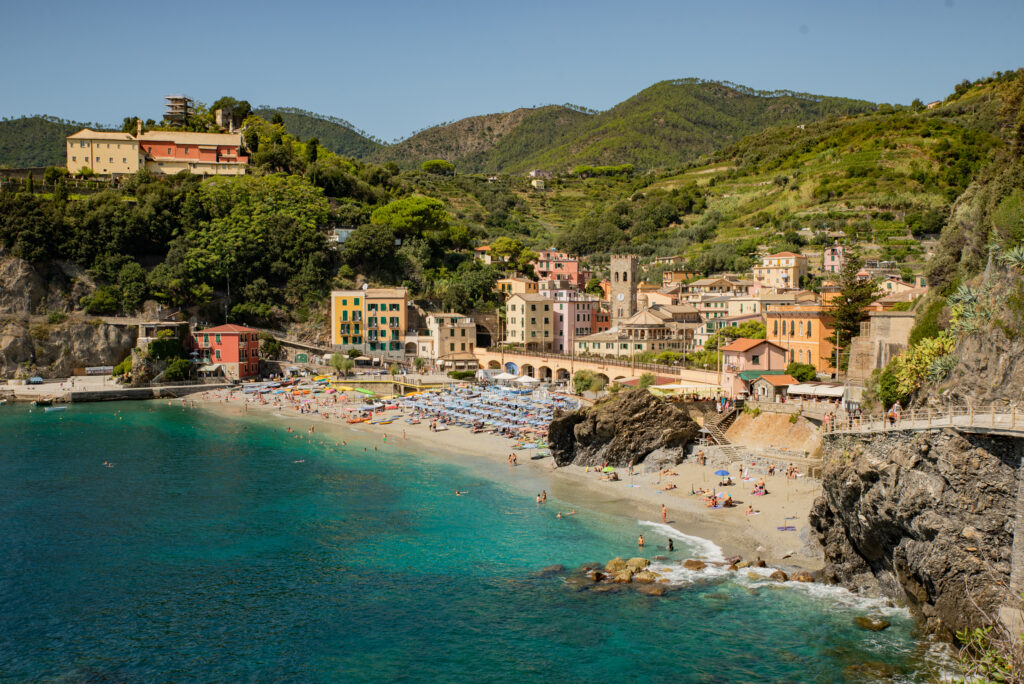
Monterosso al Mare is the biggest and the most developed of the five villages, split by a tunnel between the new part of the town and the charming old centre.
While most of the guides regard Monterosso as the least appealing of the five, it is a proper little town, and genuinely the liveliest one, with a good restaurant offering and small family producers working all year round to produce wine, pesto Genovese, and ceramics.
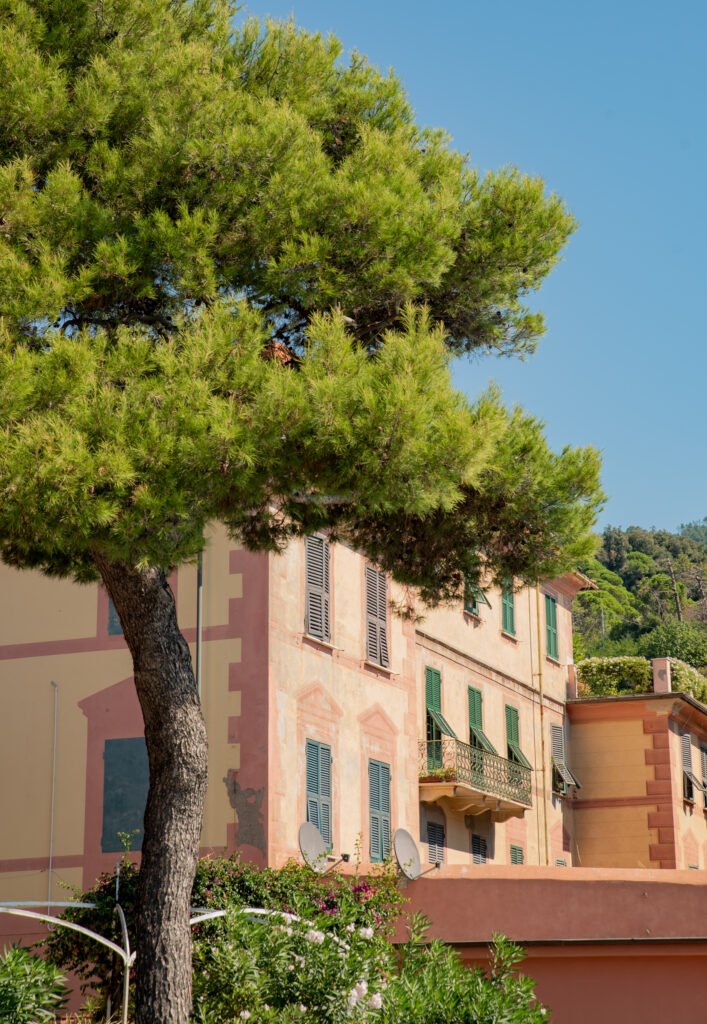
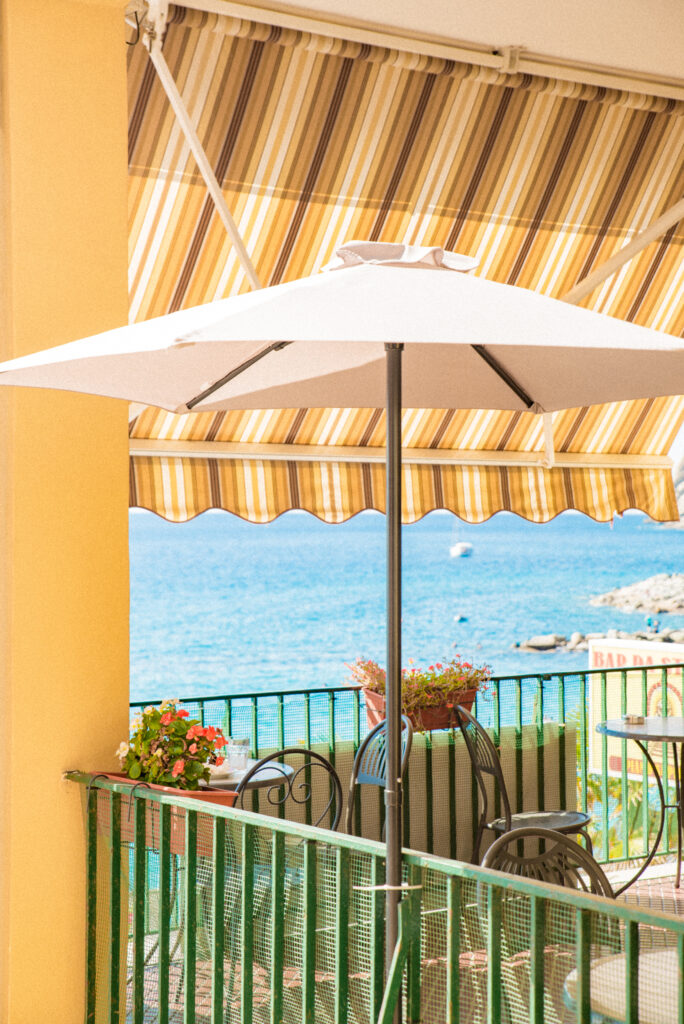
Agriturismo Buranco, situated just a couple of minutes walk up the hill from the old centre, is a perfect spot to sip on sweet local sciachettrà wine while overlooking the lush lemon orchard, the surrounding vineyards and olive trees, and the sea in the distance. It also makes a fabulous place to stay when visiting Cinque Terre!
At Baico, the Pesto Genovese Lab is run by a local family, and you can taste and buy the artisanal pesto Genovese as well as anchovies in olive oil – both typical Ligurian products.
In the streets of the old town, you’ll find the Gelateria Golosone with mouth-watering gelato (try their thick chocolate or lemon-basil combination – a true representative of the region). And don’t leave without visiting the lovely family-run ceramics studio Fabbrica d’Arte Monterosso. Inspired by the land and the colour palette of the Cinque Terre, they produce beautiful hand-thrown bowls, dishes, mugs, vases, lamps, and decorative items.
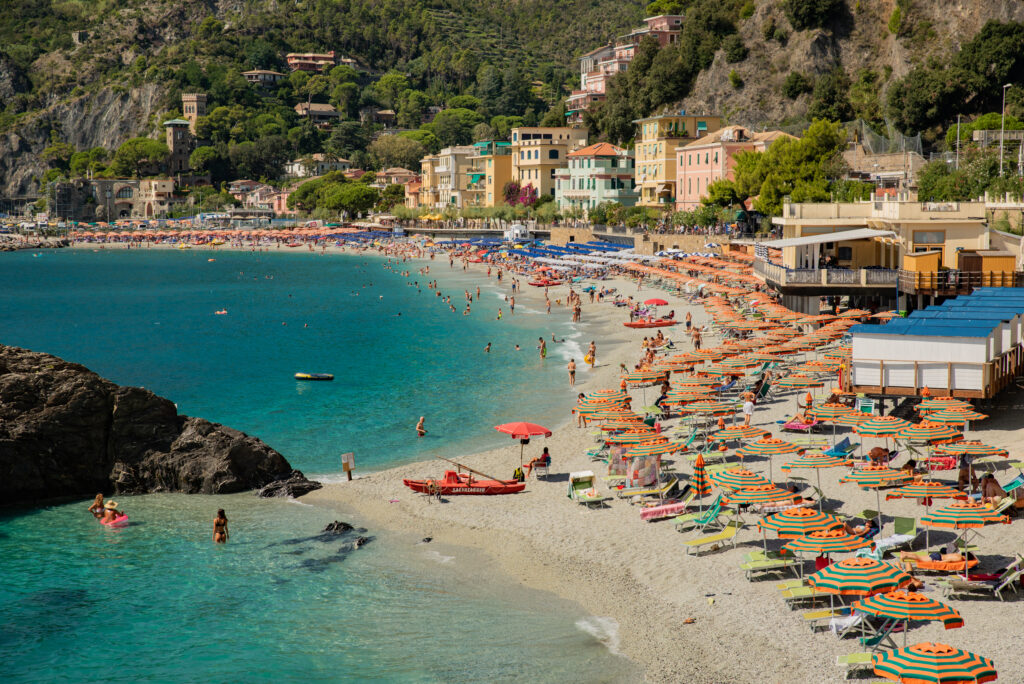
Monterosso might also be the Best Cinque Terre Town for swimming, as most of the few beaches that exist in the whole area are situated right here. You’ll be spoilt for choice with Fegina, the largest beach in the area, that has several paid areas and a small free area, Il Gigante, a family-friendly beach with a larger fee area than at Fegina, or Tragagia – situated right in front of the Monterosso old-town.
The hiking trail connecting Monterosso with the neighbouring Vernazza is one of the most popular stretches of the Blue Trail (the Sentiero Azzurro), and offers incredible views over the next village on the list…
VERNAZZA
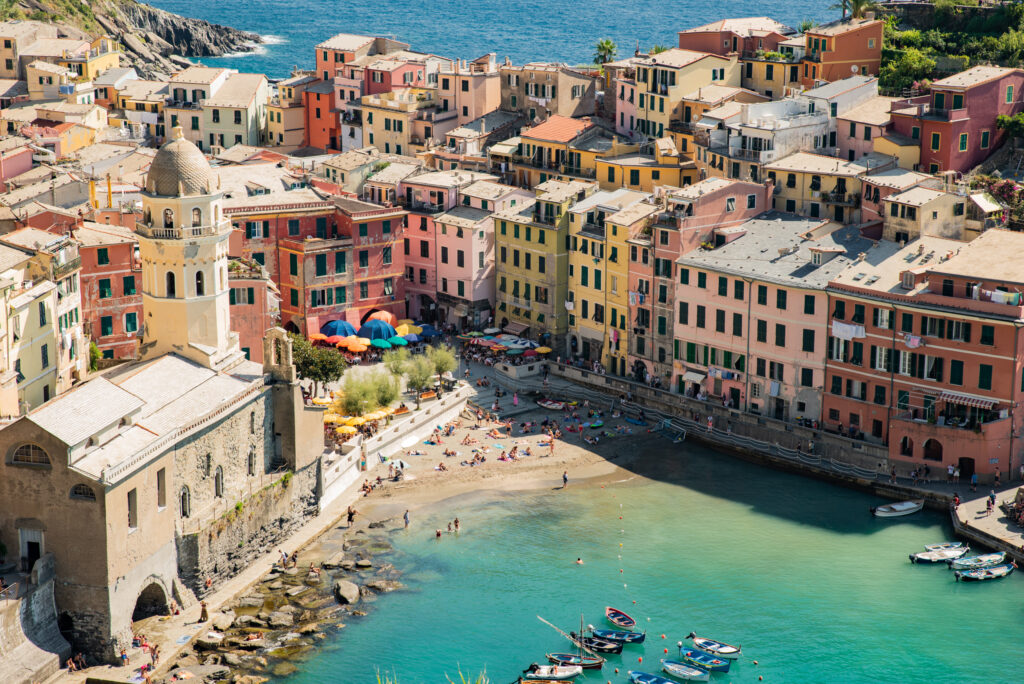
The most beautiful Cinque Terre town from above is Vernazza – projecting to the sea on a rocky cliff, its tightly packed houses and medieval tower look almost surreal when arriving from Corniglia on foot.
Medieval Doria castle was built in the mid-1500s to protect the village from pirates, when the warnings were shouted out from its Belforte tower (this is where the name is derived from). Today, you can climb up the tower, if not to spot the pirates, then to soak in the beautiful vistas of the Mediterranean and the neighbouring Monterosso.
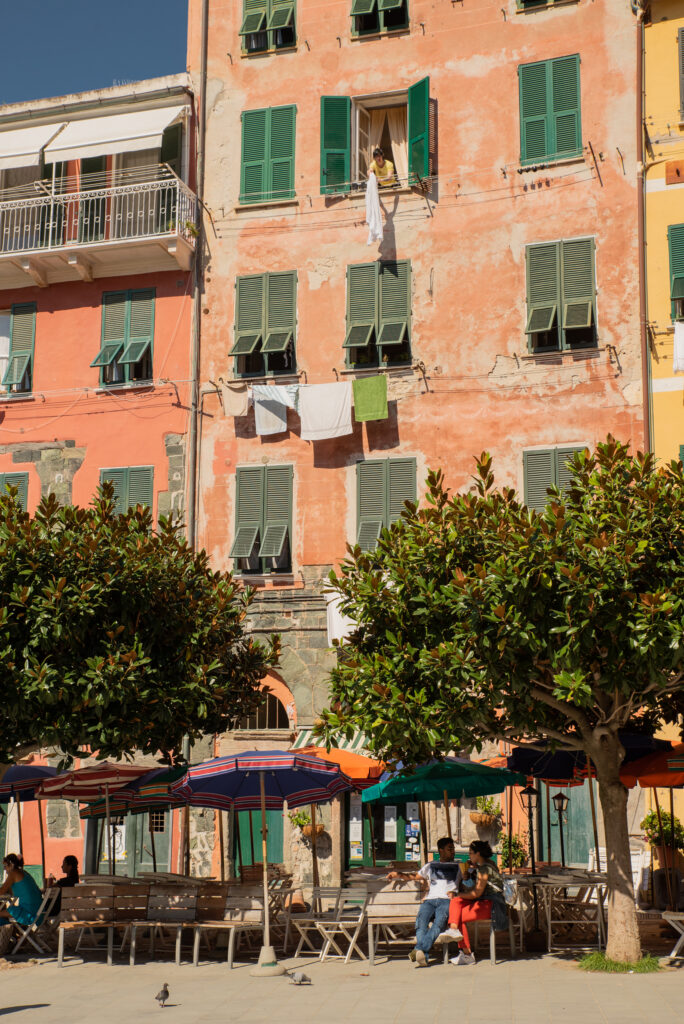
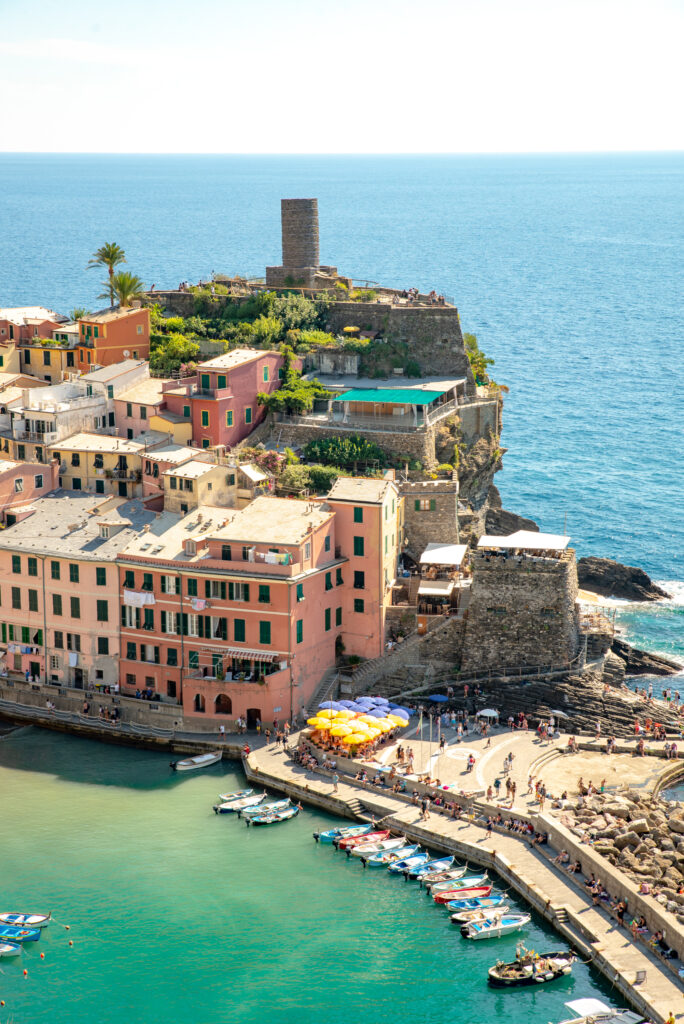
The main cobbled street connects the train station with the picturesque port and is lined with little shops, bars, and eateries. Stepping out of the main street, you’ll find yourself in a net of narrow lanes and passages called caruggi.
The port of Vernazza is the only natural harbour in the Cinque Terre, safeguarded by a breakwater (that is also a lovely spot for a passeggiata, the evening walk so typical of Italy). The harbour is home to the only Vernazza sandy beach – tiny and backed by a colourful collection of houses, restaurants, bars, and parasols of the village square.
Flanking the square, on the rock overlooking the sea, is the medieval church of Santa Margherita d’Antiochia, an ensemble of extensions and rebuildings done over the centuries.
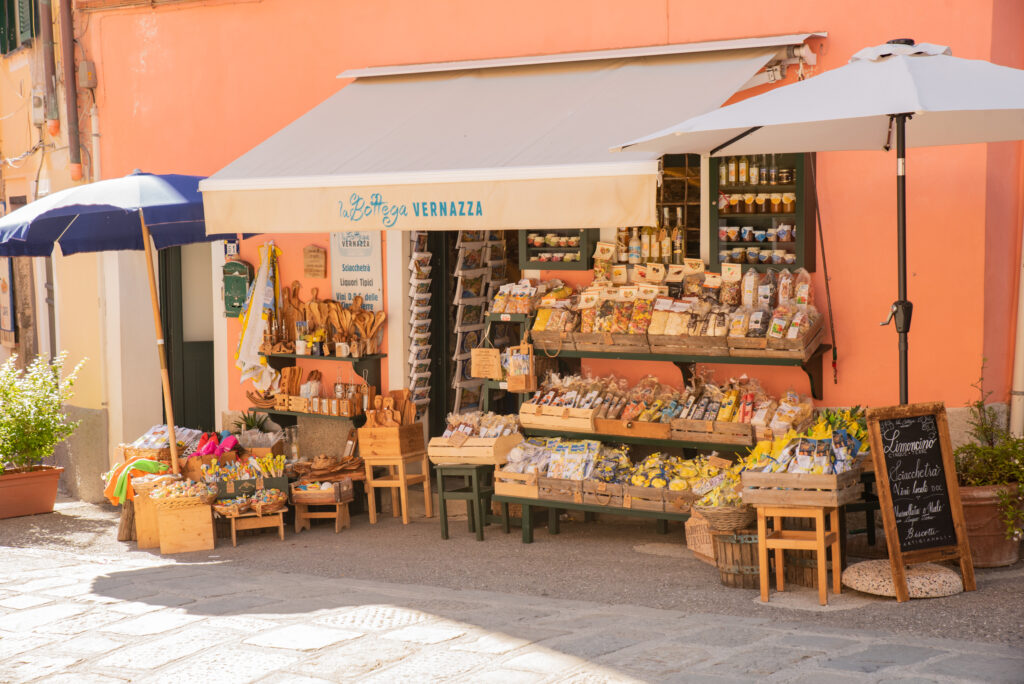
Vernazza was badly hit during the violent floods in 2011, since it was built along the Vernazzola water stream. The main street was buried under a 3-meter deep water and mud torrent. Almost all of the small businesses in the centre were destroyed then, but Vernazza managed to recover. Today, it’s a lively and colourful promenade with almost no trace of the devastation that took place 11 years ago.
The Blue Trail that connects Vernazza to Corniglia is an enjoyable, 1.5-hour-long hike with incredible views: stop at the tiny hamlet of Prevo for a spremuta or a glass of wine as refreshment before continuing to Corniglia.
CORNIGLIA
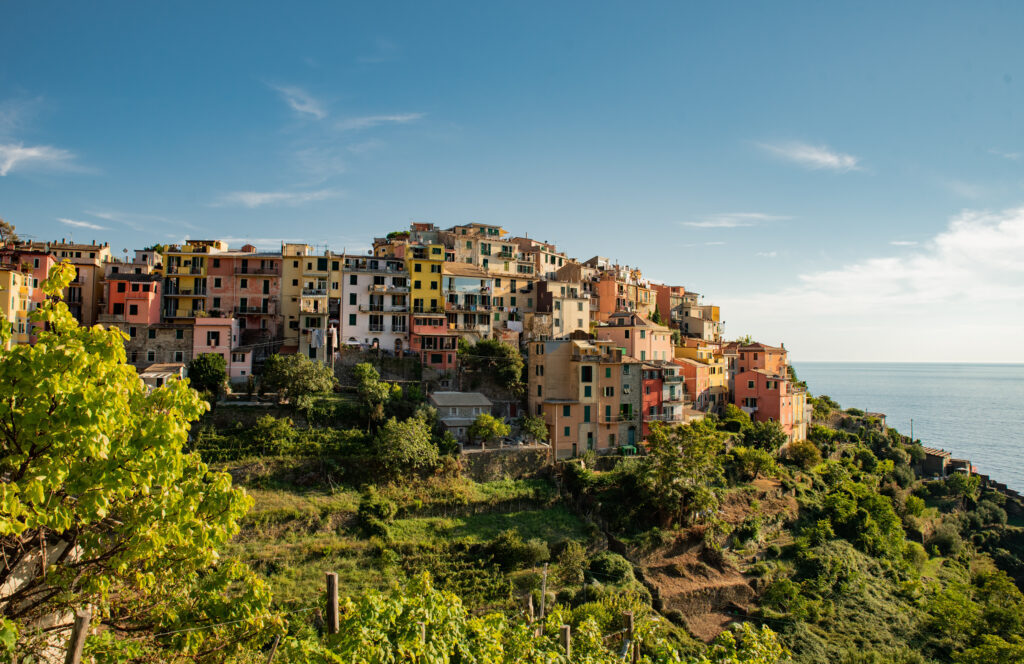
For those seeking quieter places, Corniglia is the best village in Cinque Terre to get away from the crowds. Situated on top of a 100m high cliff, the only village that’s not immediately on the sea, and nestled 377 steps above the train station, its location means it’s less frequented (large organized tours tend to avoid it).
Surrounded by vineyards and overlooking all five towns of Cinque Terre, Corniglia has a unique location and a distinct character.
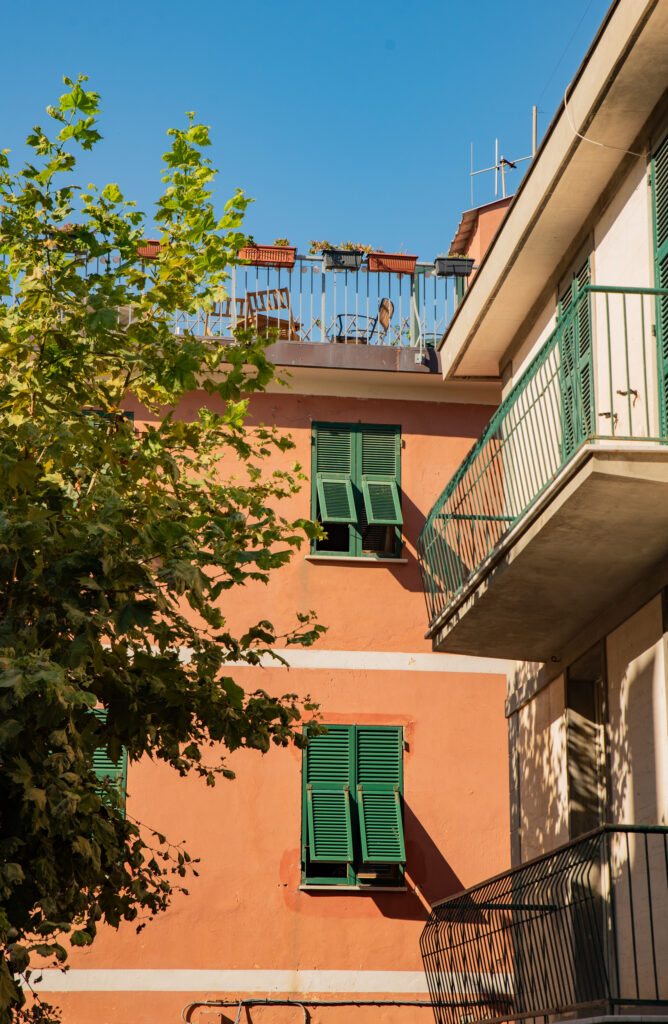
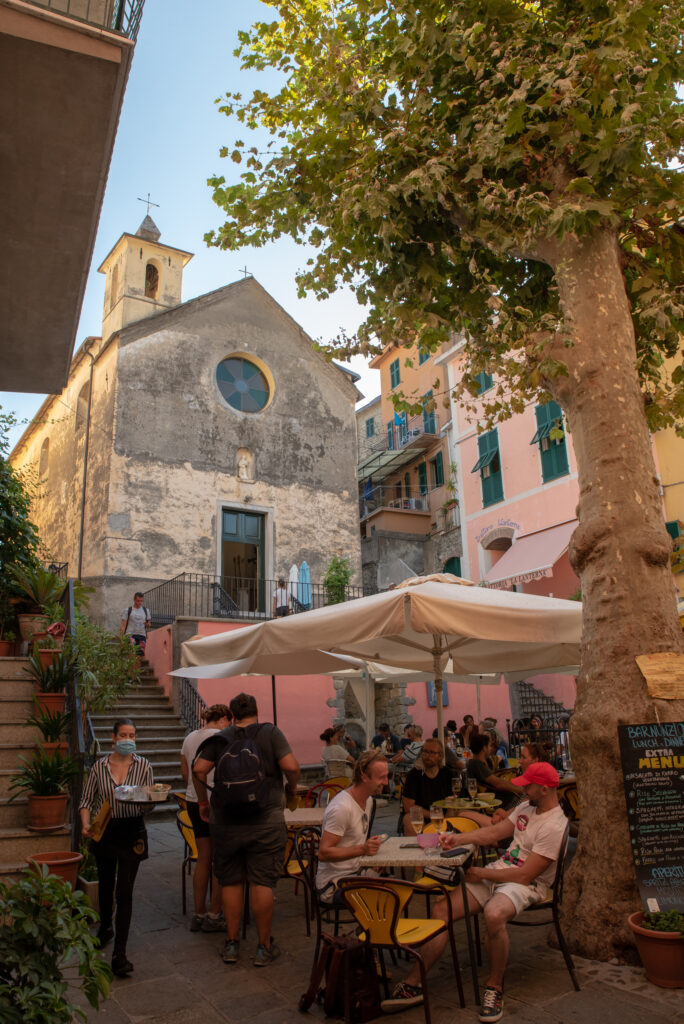
There are a decent amount of bars, cafes, trattorias, and shops selling local products in Corniglia, tending to a combination of locals and tourists. All of them are small and understated, often with fantastic views opening up from their charming leafy terraces.
Sit at the local Caffe Matteo for a morning coffee or an evening aperitivo, a place where locals gather and tourists are greeted with a smile and a chat (and a cocoa heart dusted over a cappuccino). A perfect spot for soaking in the atmosphere of the tiny, homely main square.
The viewpoint from the town wall is the place to be at sunset, and if you manage to find a spot at the bar – with an aperitivo in hand.
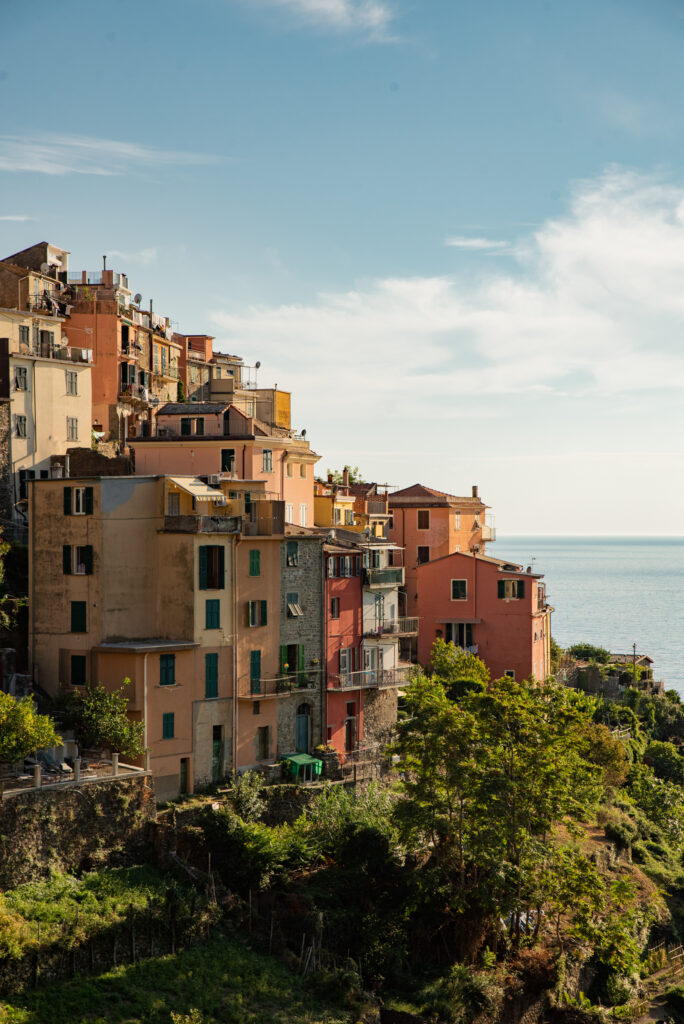
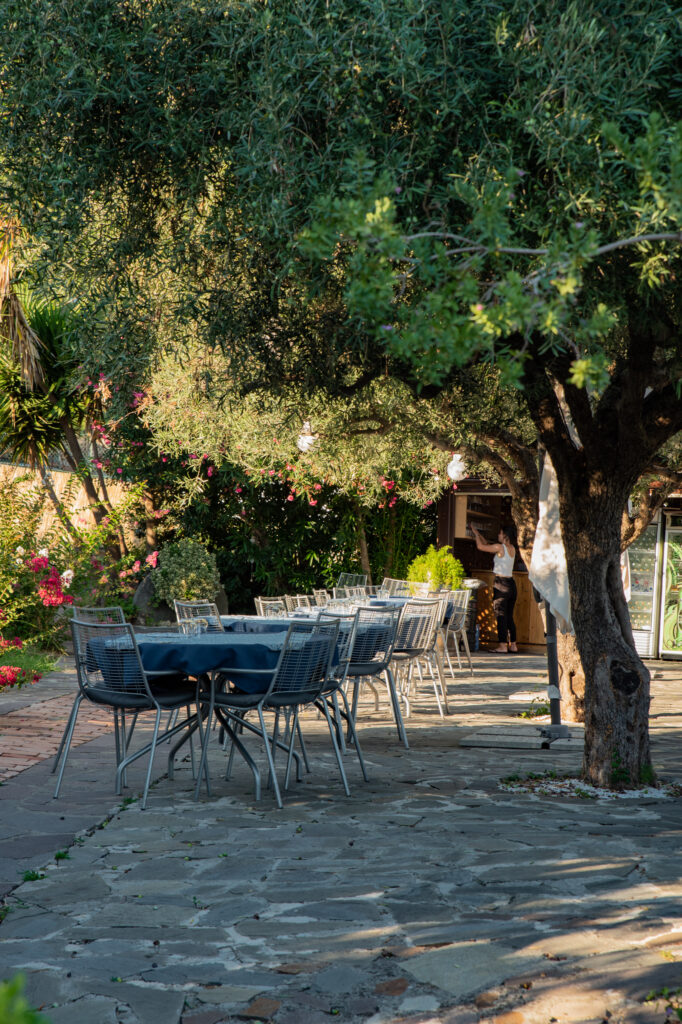
It is suitable to mention here that tap water in Cinque Terre is of high quality, with designated public water fountains available to travellers – even in Corniglia, small as it is, there are several spots where you can fill your thermos with fresh, cool water.
Sustainable travel is of even greater importance in places and communities that are not easily reachable – and Cinque Terre is doing a great job in that direction.
MANAROLA
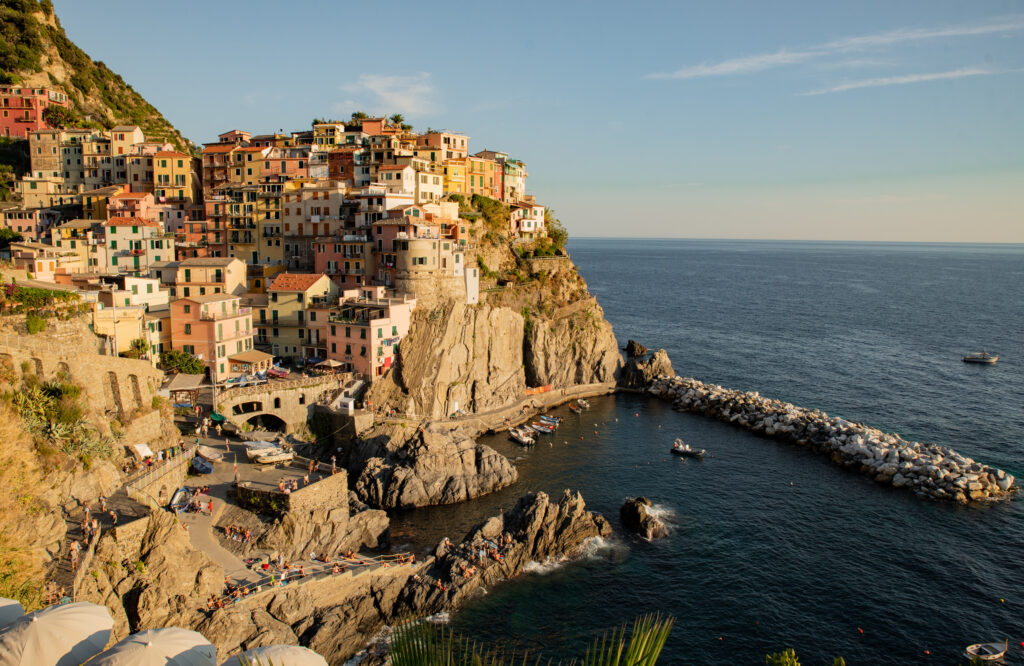
Nestled in a ravine between lush terraced vineyards, lovely Manarola is one of the best places to visit in Cinque Terre and the one with the most picturesque viticultural setting.
Not quite as touristy as its neighbour Riomaggiore, but every bit as quintessentially Ligurian, Manarola is both a good base for exploring the Cinque Terre, and a great place to spend a day drinking wine, enjoying the local delicacies, and soaking in the magical atmosphere.
Most shops and restaurants sit on the two main streets in Manarola, Via Birolli in the lower part of the town and Via Discovolo in the upper part of town. Climb up Via Discovolo to the little square in front of the church of San Lorenzo for a beautiful view.
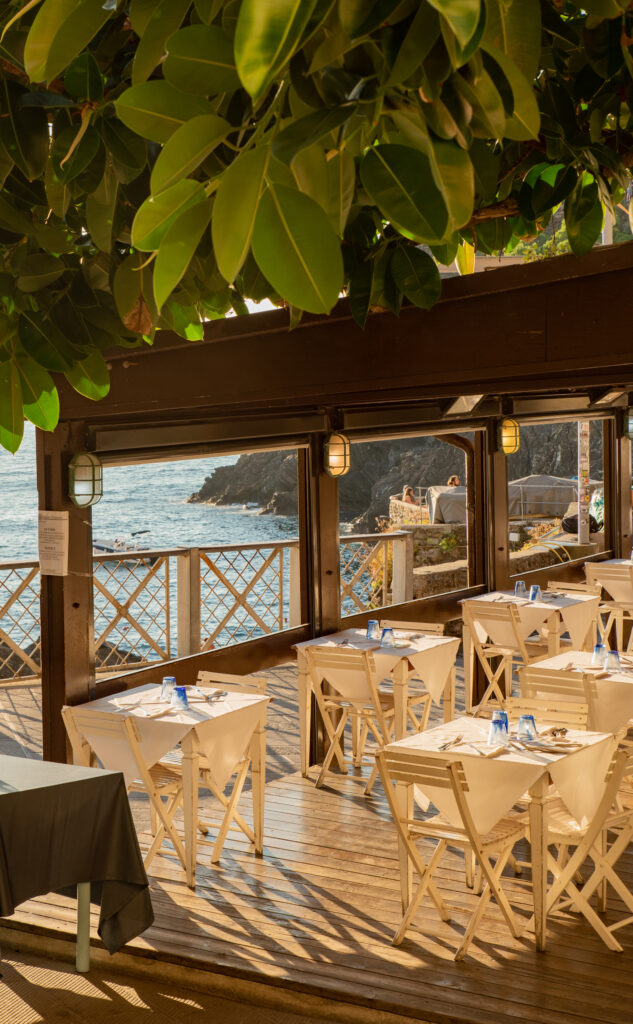
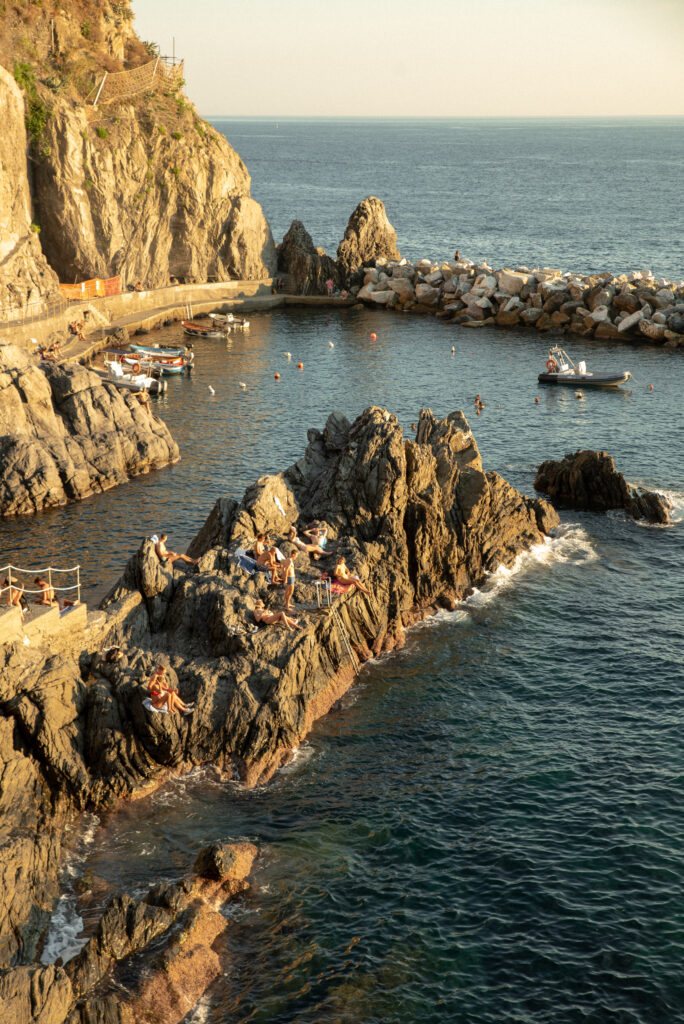
One of the most popular places to eat in Cinque Terre is situated here, in the upper part of the town – Trattoria dal Billy offers fresh seafood overlooking the sea, the vineyards, and the town below, a real-life postcard ensemble.
On the opposite part of the ravine sits Nessun Dorma bar. With a view of Manarola and the sea, it is a widely popular place to have an aperitivo, along with lush platters of cold cuts, cheese, bruschettas, and focaccias.
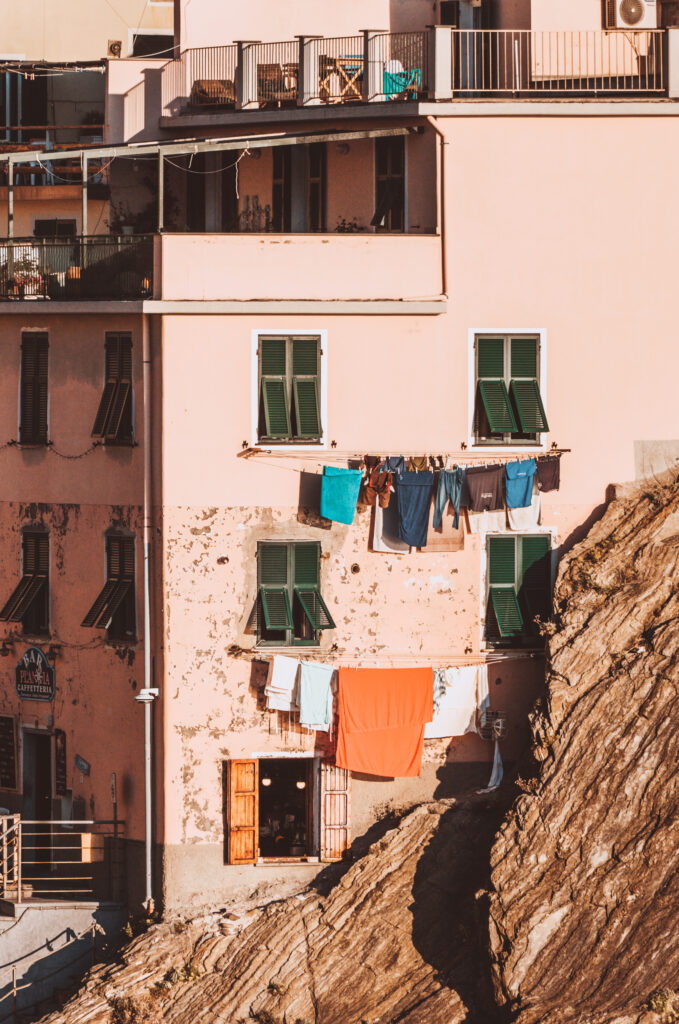
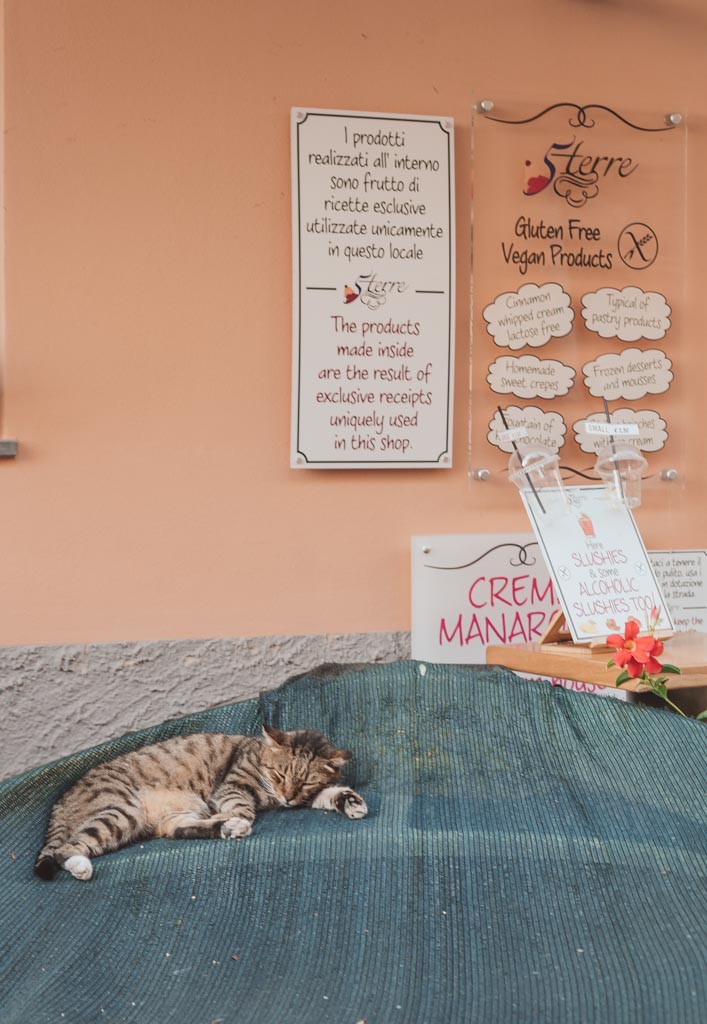
Unfortunately, due to the floods in 2011, the trails to both Corniglia and Riomaggiore are currently closed, but you can take the alternative route to Corniglia, which passes by through the vineyards via the village of Volastra, and takes around 2.5 hours to complete.
Alternatively, you can take an easy walk that crosses the vineyards encircling Manarola, as Manarola has more vineyards than any other Cinque Terre village (starting point is behind the San Lorenzo church).
Manarola doesn’t have a beach per se, but the cliffs and rocks surrounding the marina are nevertheless a popular spot for sunbathing, cliff-diving, and swimming.
RIOMAGGIORE
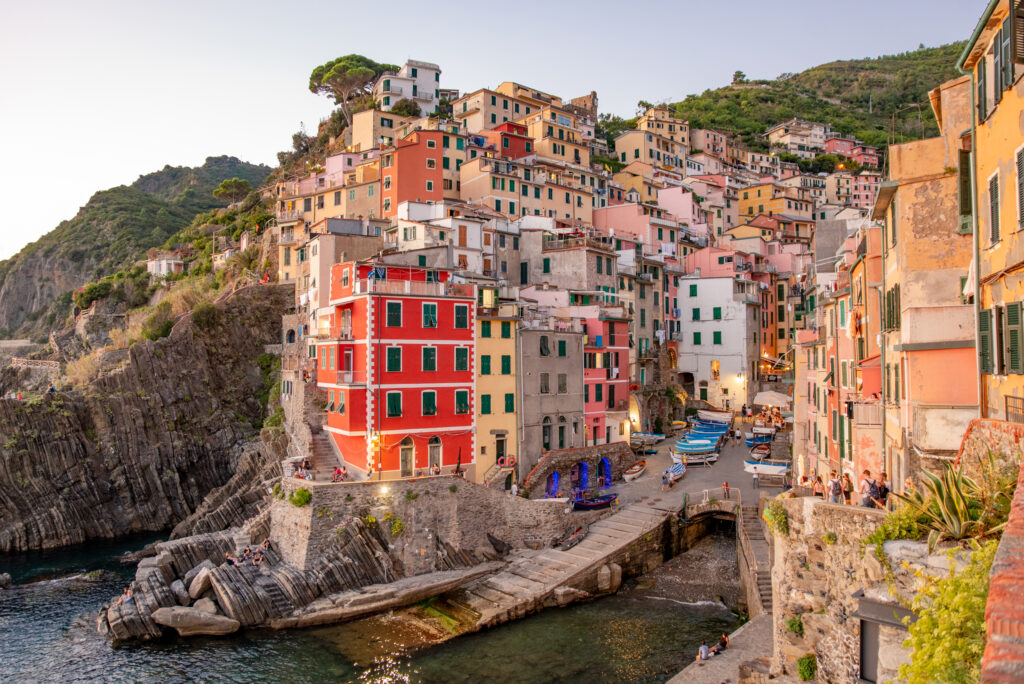
One of the main attractions in Cinque Terre is the easternmost, postcard-pretty Riomaggiore. The houses rise one atop of the other as a colourful patchwork above the harbour.
Connected by narrow alleyways and steep staircases, once you’re off the main street, you will always be climbing or descending in Riomaggiore. Climb up to mid-13th century Castello di Riomaggiore in the upper part of the village to enjoy the best views from its terrace.
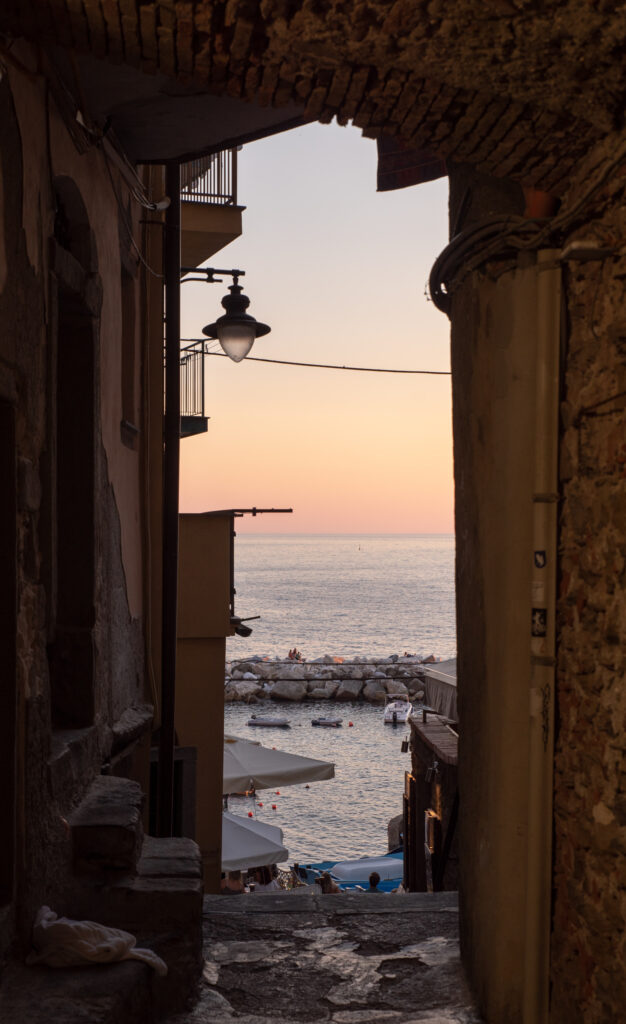
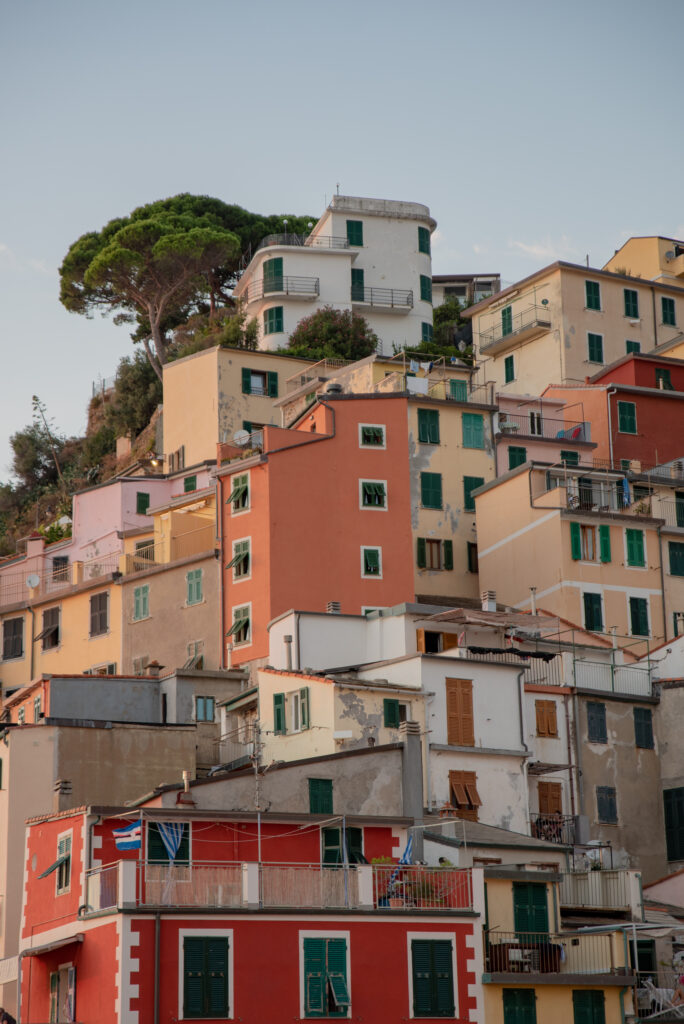
Swimming in the narrow port is forbidden, however, you can lay your towel on one of the rocks alongside the port for sunbathing, or take a couple of minutes’ walk from the main street to the Spiaggia di Riomaggiore, a beautiful place to swim if not to sunbathe.
The main street in Riomaggiore, Via Cristoforo Colombo is lined with numerous shops, restaurants, and takeaway parlours. For a fast lunch, grab a cone of fried fish at Tutti Fritti or Il Pescato Cucinato. Off-season, the colourful boats rest at the paved Via San Giacomo that leads to the port – a charming scene, especially in the late afternoon light.
Riomaggiore is also the best place to watch the sunset in the Cinque Terre. Join the crowds with a beer and a pizza as you watch the sun sink into the horizon from your perch on the rocky harbour.
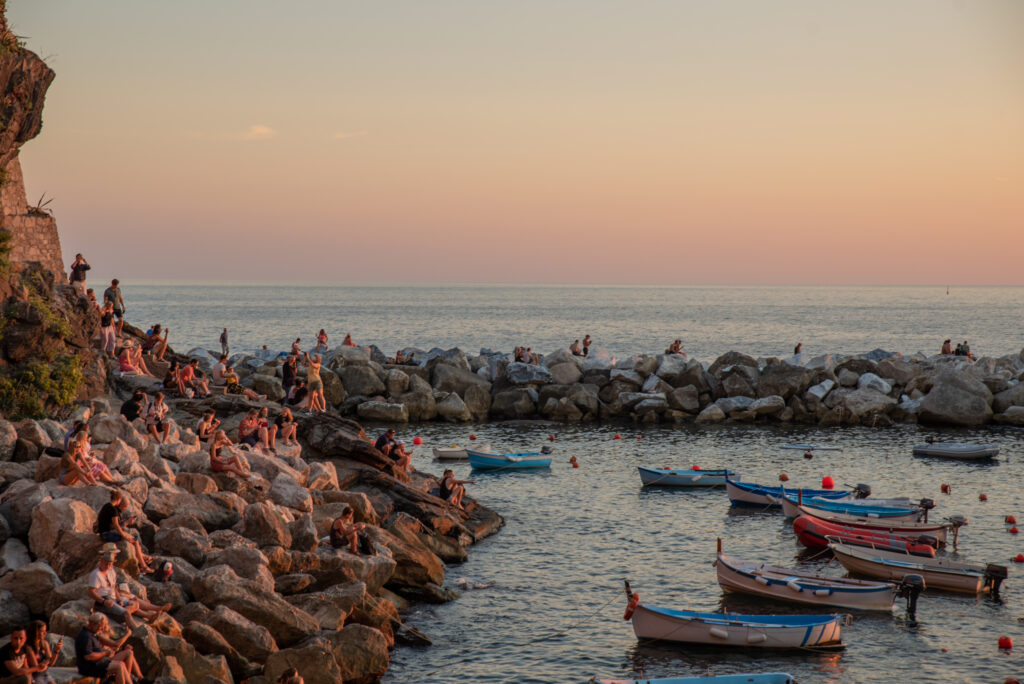
Even though Riomaggiore is the starting point for the Blue Hiking Trail, the aforementioned floods of 2011 damaged the hiking path that connects Riomaggiore and Manarola (the famous, and heavily foot-trafficked Via dell’Amore)- the expected time of reopening is 2024.
Hiking between the Villages of the Cinque Terre
One of the not-to-be-missed Cinque Terre activities is hiking. Exploring the area by foot will reward you with beautiful nature, fantastic views, and a sense of accomplishment when you enter your destination village (followed by a well-deserved lunch, gelato, or a glass of wine).
Cinque Terre hiking trails are a net of well-kept paths (sentieri), with the most popular ones that connect the picturesque towns being quite busy in the high season.
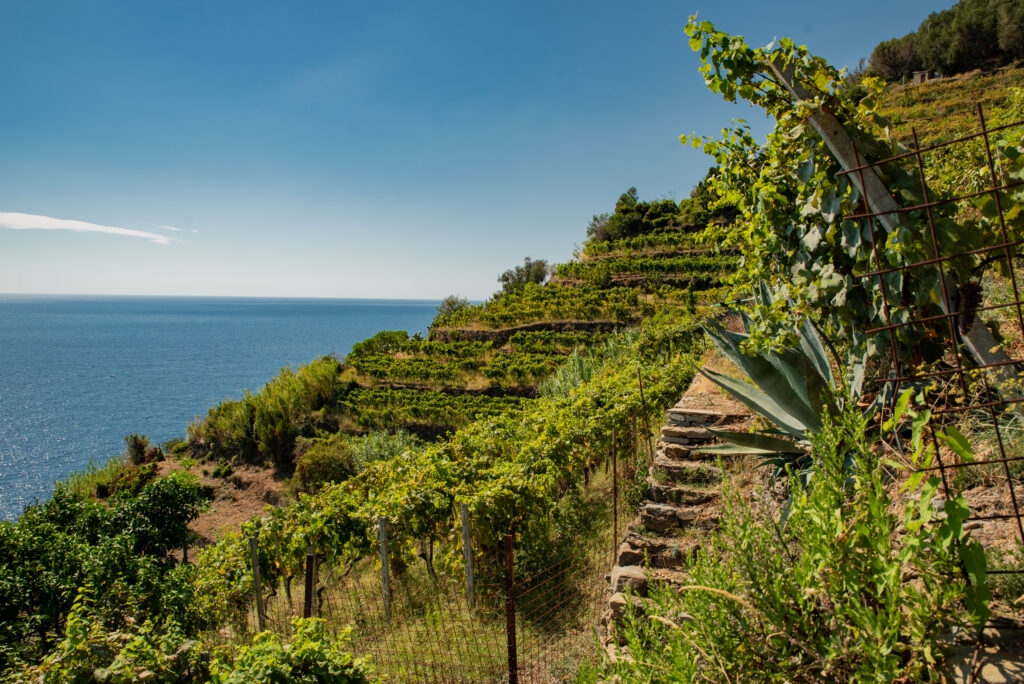
The landslides in 2011 caused damage not only to the villages, but also to the hiking trails, and some of them are still closed due to the landslides, so check before you go (for example, the entire Corniglia-Manarola-Riomaggiore route).
To walk the Blue Trail (Sentiero Azzurro, or Sentiero no.2), the coastal path connecting the five villages, you will need to buy the Cinque Terre Trekking Card, which costs 7.50 Eur per day per person, or the Cinque Terre Card, that includes both the hiking trails and unlimited train rides, for 18.20 Eur per day per person.
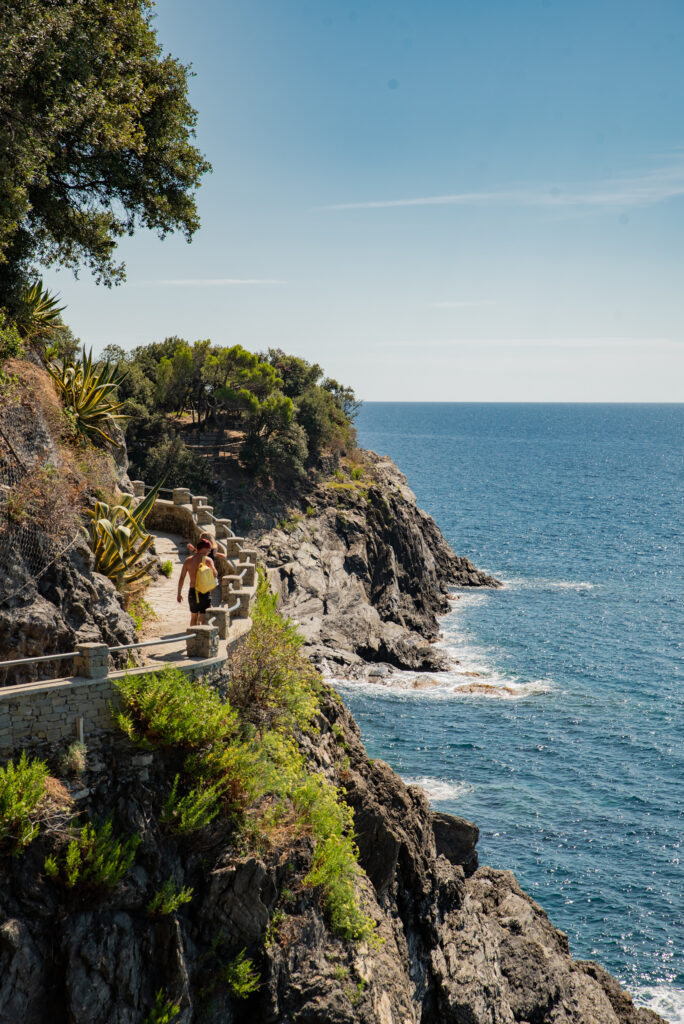
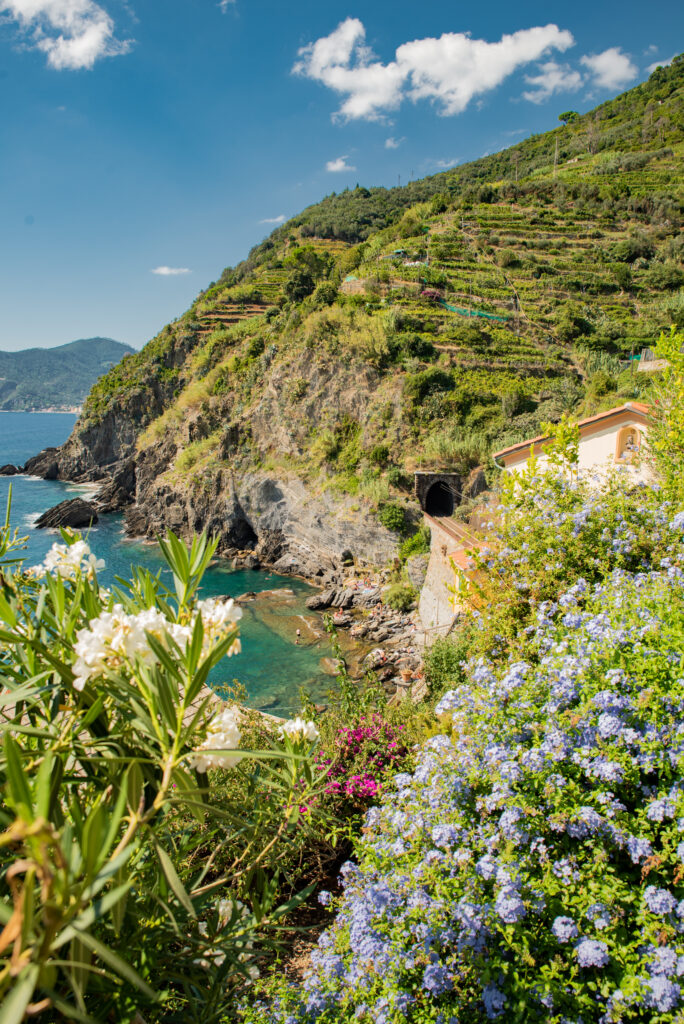
The Red Trail (Sentiero no.1) that runs on the ridge above the five villages is less popular and free of charge, while still providing beautiful vistas. Even though the trails are well kept, keep in mind that you will need proper shoes and plenty of water for hiking (especially in the summer months).
Other Places of Interest to Visit Near Cinque Terre
The Cinque Terre is located in a beautiful part of Italy, and the entire riviera running from Genoa to La Spezia is worth visiting. There are a lot of places near Cinque Terre that would make a lovely day trip: from Genoa to Portofino, Santa Margherita Ligure, Rapallo, Chiavari, and Portovenere, some of which are world-famous glitzy resorts, and some understated, yet beautiful Italian towns.
We chose to spend more time in Portovenere, an under-the-radar Cinque Terre neighbour (but every bit as charming), and Genoa, Liguria’s flag-bearer – the often overlooked but quintessentially Italian port city.
PORTOVENERE
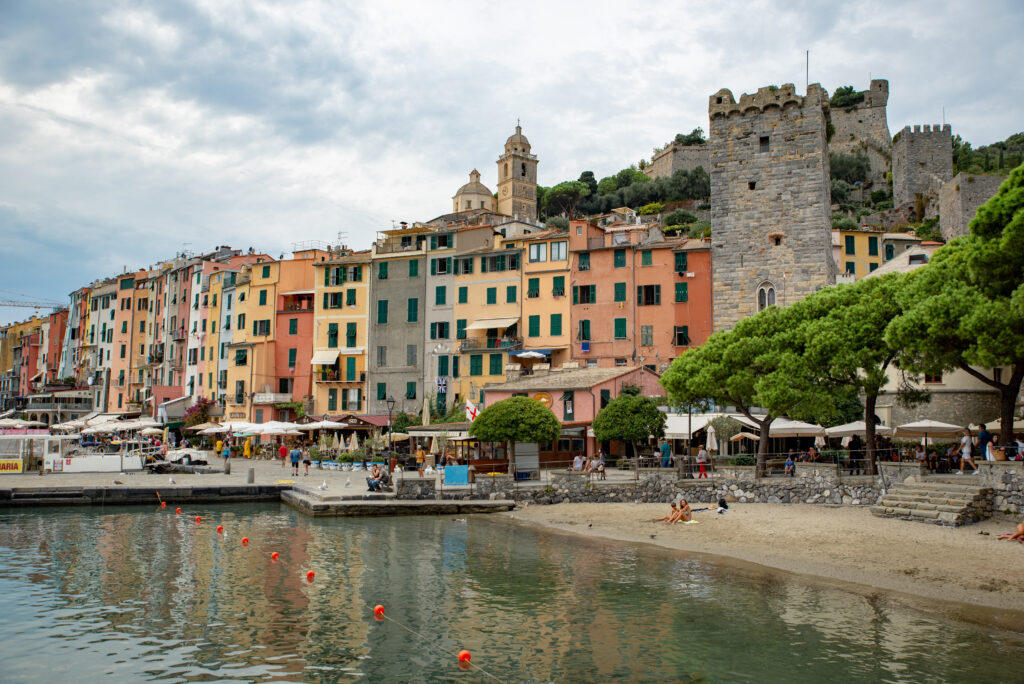
Towns near Cinque Terre often get overlooked by their world-famous neighbours, but Portovenere (also called Porto Venere) has all the picturesque appeal of the Cinque Terre minus the crowds.
Soaking in the riviera vibes in a more relaxed atmosphere is indeed possible in Portovenere. Overlooking the gulf of La Spezia, this fishing village is adorned with tall, colourful houses typical of the region, situated on the waterfront and covering a maze of narrow streets and stone staircases.
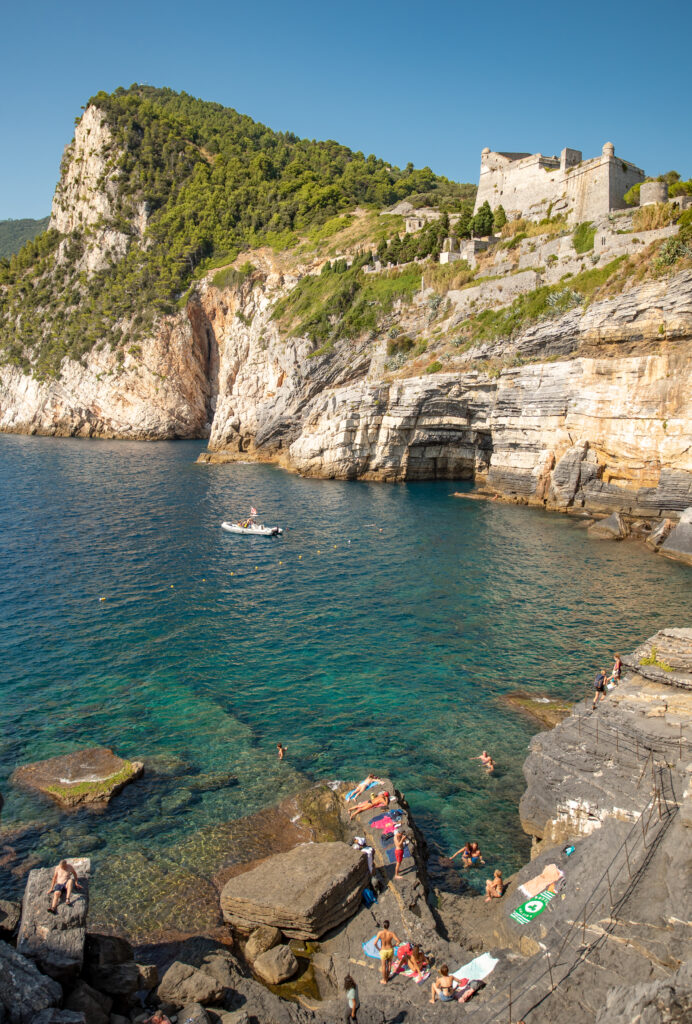
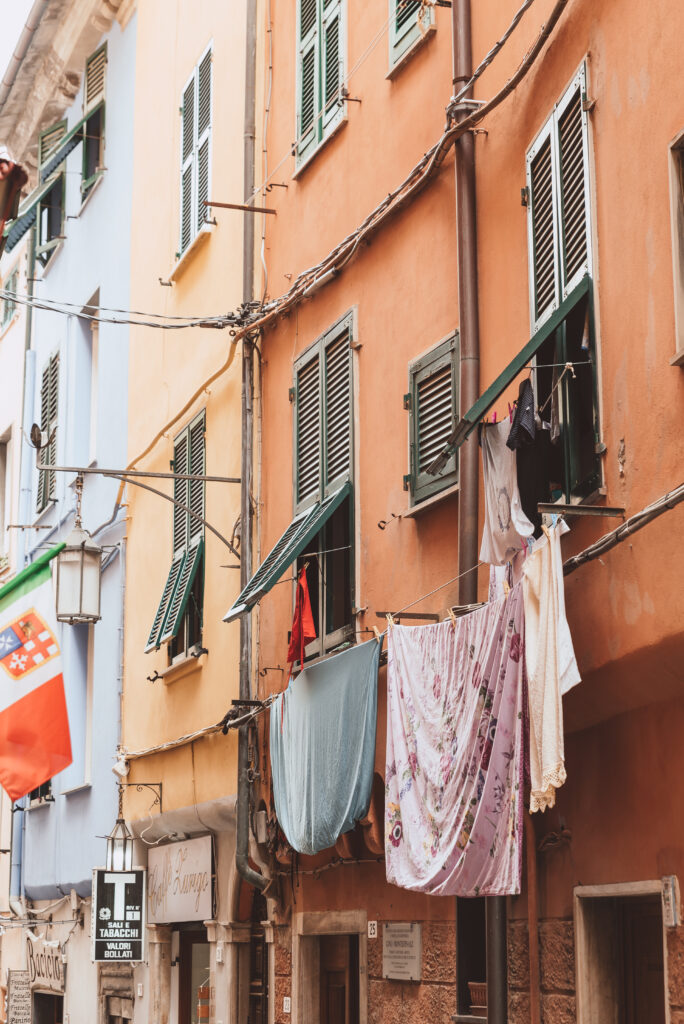
As opposed to mostly medieval Cinque Terre villages, Portovenere was an important commercial centre already in Roman times. There is the medieval Castello Doria, too, that stands here since the Famous Genovese family ruled the city. Note that behind the castle starts the Cinque Terre Sentiero Rosso hiking trail to Levanto.
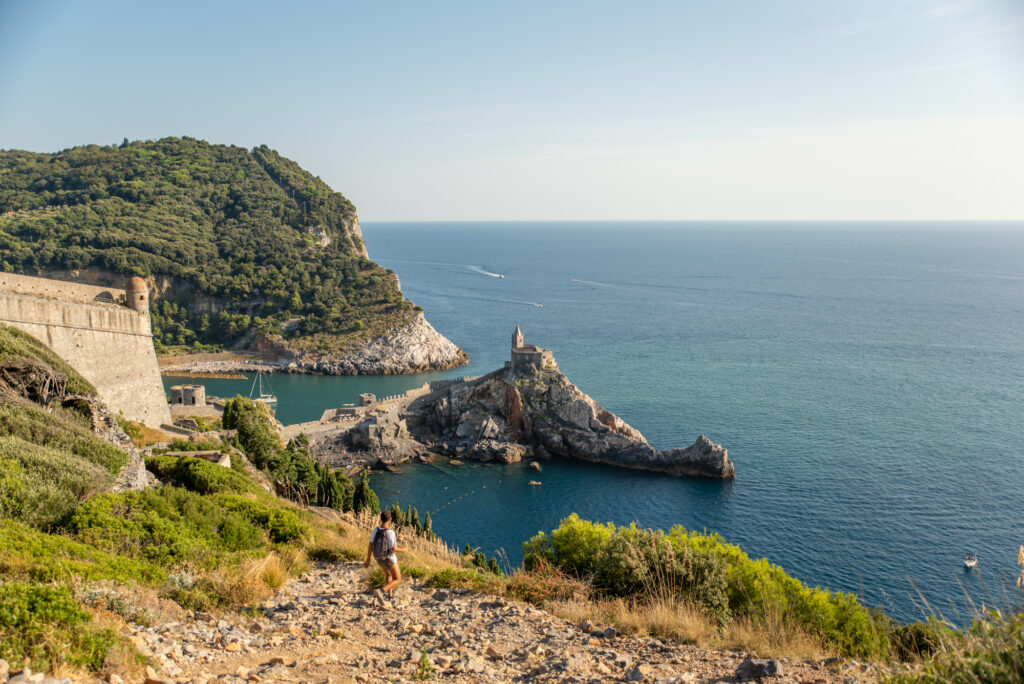
Even though the town and its archipelago, the Palmaria islands, gained Unesco World Heritage status, the absence of the train station keeps it off the beaten track. Portovenere also has several spacious pebble beaches for sunbathing and swimming, with both paid and free areas.
GENOA
Nicknamed La Superba, glorious and gritty at the same time, a maze of dark narrow alleys called caruggi, and grandiose bright piazzas adorned with lush churches and palaces, Genova is not catered to tourists, and thus a perfect place to immerse into Italian city life.
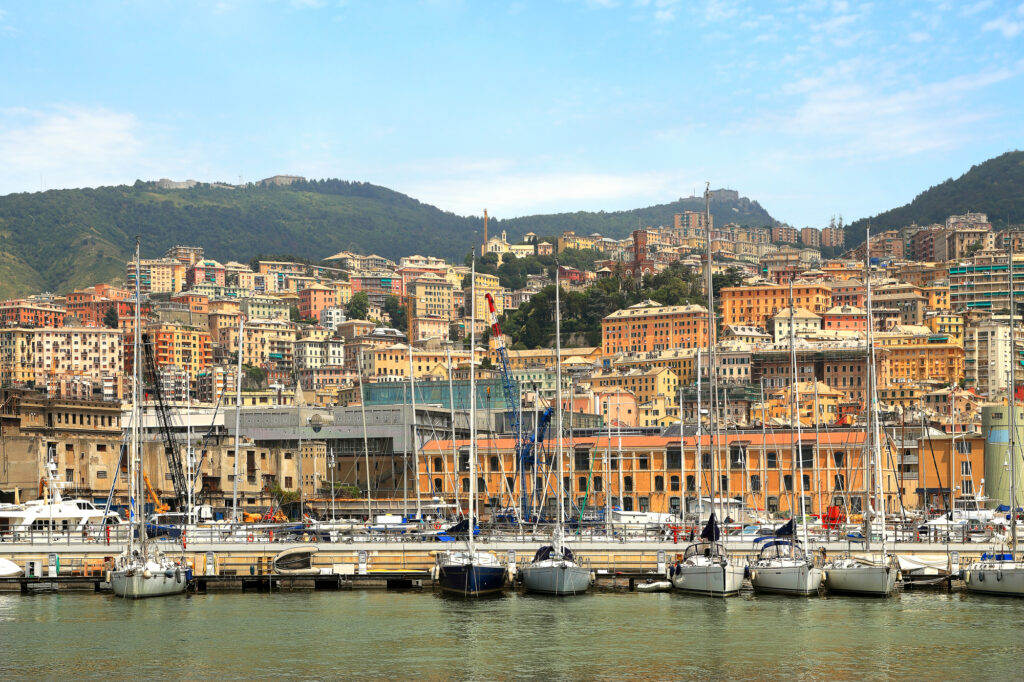
The whole town is built vertically, up into the hill, with tall townhouses in ochre and peach colour palette and facades adorned with architectural illusionist paintings (an architectural feature that is typical of the region). Genoa is also home to the 42 Renaissance and Baroque palaces placed on the Unesco World Heritage list, known as Palazzi dei Rolli.
Genovese cuisine is as rich as its palazzi and as down-to-earth as its caruggi- in any case, not to be missed. The focaccie, farinate, and torte di riso intertwine with pesto Genovese, homemade pasta, and fresh fish in a whirlwind offer of bakeries, simple eateries, trattorias, and fancy restaurants.
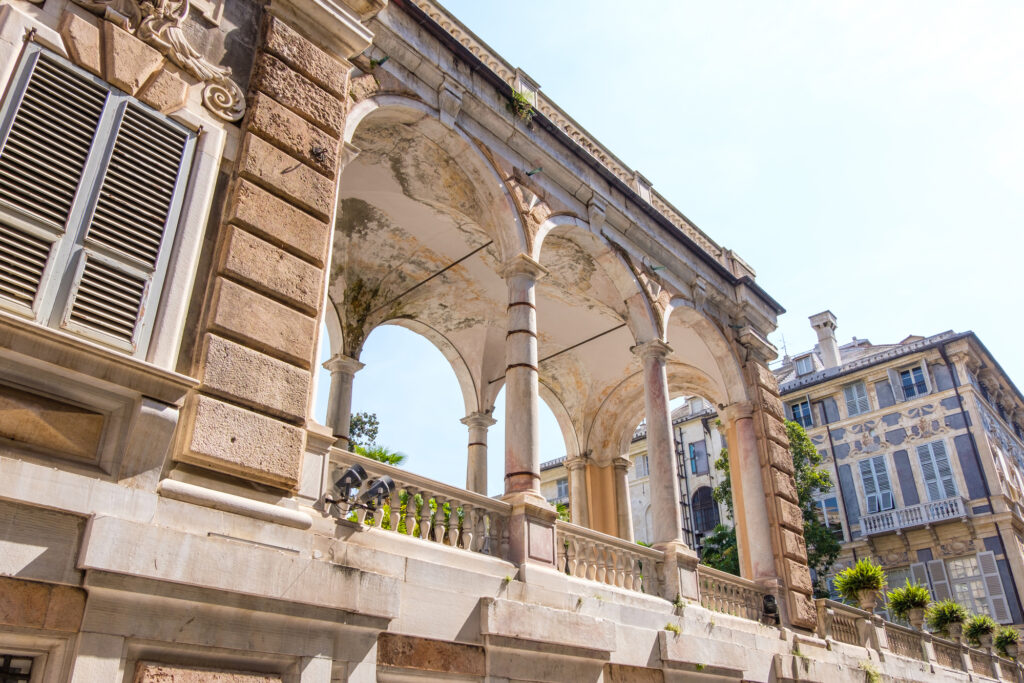
A walk in the old port is as essential as a walk in the carruggi: native son Renzo Piano did the harbour redevelopment for Expo 92 with the idea to reconnect the city with its port. One of the main attractions of this development is the panoramic lift Bigo: slowly climbing and rotating, it offers fantastic panoramic views of both the city and the port.
The whole stretch of the Ligurian coast between Genoa and La Spezia is a traveller’s Italian dream. A dramatic coastline, colourful seaside villages, riviera glitz and glamour, stone-walled terraces where the local people have been farming using traditional methods for a thousand years, hiking paths offering spectacular views, and omnipresent turquoise of the Mediterranean, all spiced up with some of the best Italian food and wine.
On a quest to visit all five Cinque Terre villages, don’t forget to sit down and enjoy the atmosphere by sipping on sweet local wine or freshly squeezed lemon juice – focaccia in hand, for a true Ligurian experience.
Written by Anja Bendeković Žuljević
Anja is an art historian that runs a craft distillery with her husband in the south of the Istrian peninsula, Croatia. She likes to travel slowly, most often to Italy, as she believes that the Italians cracked the secret of the good life (and there’s only one way to prove it).

